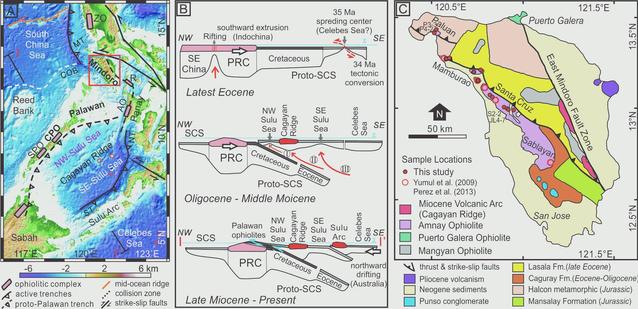Mengming Yu1, 2, Yildirim Dilek3, Graciano P. Yumul Jr 4, Yi Yan2*, Carla B. Dimalanta5, Chi-Yue Huang1
1 State Key Laboratory of Marine Geology, Tongji University, Shanghai, China;
2 Key Laboratory of Ocean and Marginal Sea Geology, Guangzhou Institute of Geochemistry, Chinese Academy of Sciences, Guangzhou, China;
3 Department of Geology & Environmental Earth Science, Miami University, Ohio, USA;
4 Cordillera Exploration Company Incorporated, Metro Manila, Philippines;
5 National Institute of Geological Sciences, University of the Philippines, Diliman, Philippines
Abstract:
Supra-subduction zone (SSZ) ophiolites formed in forearc settings and the Izu–Bonin–Mariana (IBM) in-situ forearc show conversions from normal mid-ocean ridge basalt (MORB) to boninitic affinities, which are widely interpreted as rules for the evolving chemical geodynamics of subduction initiation magmatism (SIM). Nevertheless, forearc sequence generated by subduction initiation need not always include boninitic rocks. Here we reconstruct a forearc chemostratigraphy without boninitic affinity based on the Central Palawan and Amnay (CPA) ophiolites of the west Philippines to show diversity in melt evolution of SIM. Zircon U–Pb dating on the MORB-type Amnay gabbros reveal a 10 m.y. of seafloor spreading from 33 to 23 Ma. These ages together with the progressively enriched zircon in-situ oxygen isotopes (δ18O= 1.62–10.1‰) and whole rock elemental and Nd–Hf isotopic signatures ([La/Yb]N= 0.19–3.45; Nb/Yb= 0.07–5.24; εNd= 2.1–10.2; εHf= 11.2–24.1) indicate that the depleted MORB mantle (DMM)-type source of the Amnay ophiolite was getting enriched by fluxing of aqueous slab fluid in the early stage followed by addition of adakitic and Nb-enriched slab melts in the later stage. This distinct mantle evolution together with higher εHf at a given εNd of the Amnay mafic samples than the contemporaneous South China Sea (SCS) oceanic samples do not support previous interpretation that the Amnay ophiolite was a fragment of the SCS. However, the 33–23 Ma Amnay ophiolite can be the younger part of the 34 Ma forearc-type Central Palawan ophiolite, and both (i.e. the CPA ophiolites) represent on-land fragments of the NW Sulu Sea. We propose that the 34–23 Ma CPA ophiolites and the NW Sulu Sea constitute forearc basin of the late Oligocene–middle Miocene island arc–backarc basin duo of the Cagayan Ridge and SE Sulu Sea, associated with subduction of the Cretaceous to Eocene Proto-SCS since 34 Ma. The CPA ophiolites lack boninite but show geochemical progression from normal to enriched MORB affinities, whose melt evolution differs from that of the IBM SIM. We attribute the differences in SIM and variations in forearc chemostratigraphy to the subduction of a younger slab with thick terrigenous sediment cover of the Proto-SCS versus an older slab with thin pelagic sediment cover of the Pacific Plate.
Full article: https://authors.elsevier.com/c/1anwa,Ig4Kpmc



